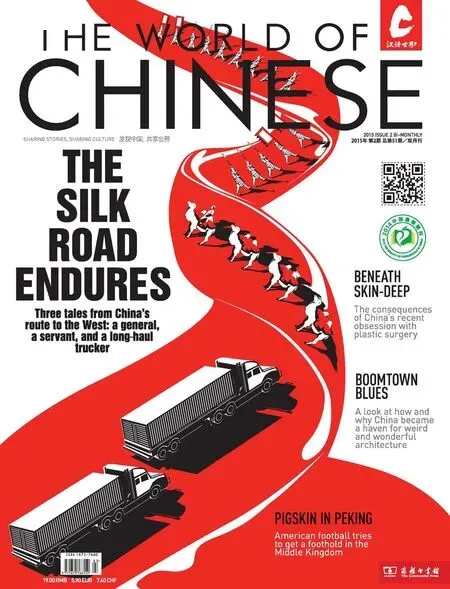丝
ON THE CHARACTER
丝
Threads in the silk tapestry
从远古绵延至今,话不尽的千丝万缕
A symbol of luxury, this smooth, exquisite, translucent fabric was once blamed for having corrupted the Roman Empire—a material that allowed Roman women to faunt their exotic dresses in public. As to its origin, it was commonly believed at the time that it grew on trees far away. Philosopher Pliny the Elder, for one, described a mysterious people living on the eastern edge of the world called the Seres. He recorded in his encyclopedic work Natural History that the Seres soak tree leaves in water and then comb off the white down, which was later woven into silk. Pliny also depicted the Seres as being “mild in character”and “resembling wild animals, since they shun the remainder of mankind, and wait for trade to come to them”.
We now know that good ol’ Pliny was pretty far off the mark. The word “silk” comes from the Greek word “serikos”, which in turn was borrowed from the Chinese word 丝 (sī). The character’s earliest form appeared as a pictorial symbol of a pair of thread bundles. Legend has it that the Yellow Emperor’s (黄帝) wife Leizu (嫘祖) was the frst to rear mulberry silkworms and invented the method to reel silk from cocoons. Archeologists, on the other hand, have put the date of China’s silk production to more than 5,000 years ago, supported by evidence such as a piece of light purple red silk wrapping the body of an infant excavated in the Neolithic Yangshao cultural site in Xingyang, Henan Province. Scholars thus hypothesize that the metamorphosis of silkworms from larvae to moth symbolized rebirth to the ancient people. Though large scale silk trade with the Weststarted in Western Han Dynasty (206 BCE – 25 CE), traders in Pliny’s time wouldn’t have been privy to the process of silk making—a closely guarded secret in the realm. What Pliny may have been describing was people picking mulberry tree leaves to feed to the silkworms and the reeling of cocoons in hot water.


ORACLE BONE SCRlPT

SEAL SCRlPT

CURSlVE SCRlPT

REGULAR SCRlPT
Silk production was an important part of ancient Chinese life, from which many frequently used phrases were derived. For instance, 抽丝剥茧 (chōusī bōjiǎn) literally means “to reel silk from a cocoon” and is used metaphorically to describe the action of hunting for logical clues in a confused or chaotic situation. Another common saying, 病来如山倒,病去如抽丝 (bìng lái rú shān dǎo, bìng qù rú chōu sī), states that“illness comes like a landslide, but goes like reeling silk from a cocoon”, meaning that people should be patient in recovery. Another phrase, 丝丝入扣 (sīsī rùkòu), is used to describe artistic performances done with meticulous care and fawless artistry, literally referring to the weaving process where the threads are closely knit together.
A large number of related words also contain the silk radical, 纟, such as in纺织 (fǎngzhī, textile) and 缝纫 (féngrèn, tailoring). Whenever you see the 纟radical in a character, you can make a not-so-wild guess that it has something to do with textiles.
丝绸 (sīchóu) refers to silk cloth, while丝 alone more or less represents its string stage. Therefore, 丝 also refers to strip-shaped objects that are long and soft. In the culinary world, add 丝 behind an ingredient to mean “sliced”, such as“sliced potato”, or 土豆丝 (tǔdòusī), and“sliced meat”, or 肉丝 (ròusī).
Silk threads are used as strings on certain musical instruments, giving 丝 the meaning “stringed instruments”, usually referring to the erhu, the Chinese lute pipa, and the zither. The term 丝竹 (sīzhú) makes up China’s favorite traditional musical duo, strings and the bamboo fute, referring to “instrumental music” in general.
Perhaps inspired by the soft fabric’s shine and luster, 丝 also carries with it a gentle and romantic connotation. For instance,青丝 (qīngsī, black threads) means long black hair, usually in reference to great beauty. For the sentimental type, a drizzle is 雨丝 (yǔsī, rain threads), which conjures up the image of a world covered in haze. Poets would describe love or sorrow in terms of long-lasting threads, as in 情丝 (qíngsī, love threads) and 愁丝 (chóusī, sorrow threads).
丝 is used metaphorically in many interesting phrases, such as 藕断丝连 (ǒuduàn sīlián, the lotus root snaps but its fber stays joined), referring to the lingering affection separated lovers have for each other. 蛛丝马迹 (zhūsī mǎjì, thread of a spider and trail of a house) refers to clues or traces.
And, because the silk threads are extremely thin (one cocoon normally yields a thread hundreds to thousands of meters long), 丝 also describes how tiny things are, such as 丝毫 (sīháo, thread and hair), meaning “the slightest amount or degree”. In the same sense, it also refers to subtle feelings or senses, such as 凉丝丝(liángsīsī, slightly cold) and 甜丝丝 (tiánsīsī, slightly sweet).
As an ancient and revered fabric that is still greatly appreciated today, 丝 has infuence in China and throughout the world. Wars have been fought over it and its mysteries were hidden for centuries, but perhaps most impressively, this little fabric has evolved over the ages in our language.
- BY HUANG WElJlA (黄伟嘉) AND LlU JUE (刘珏)

